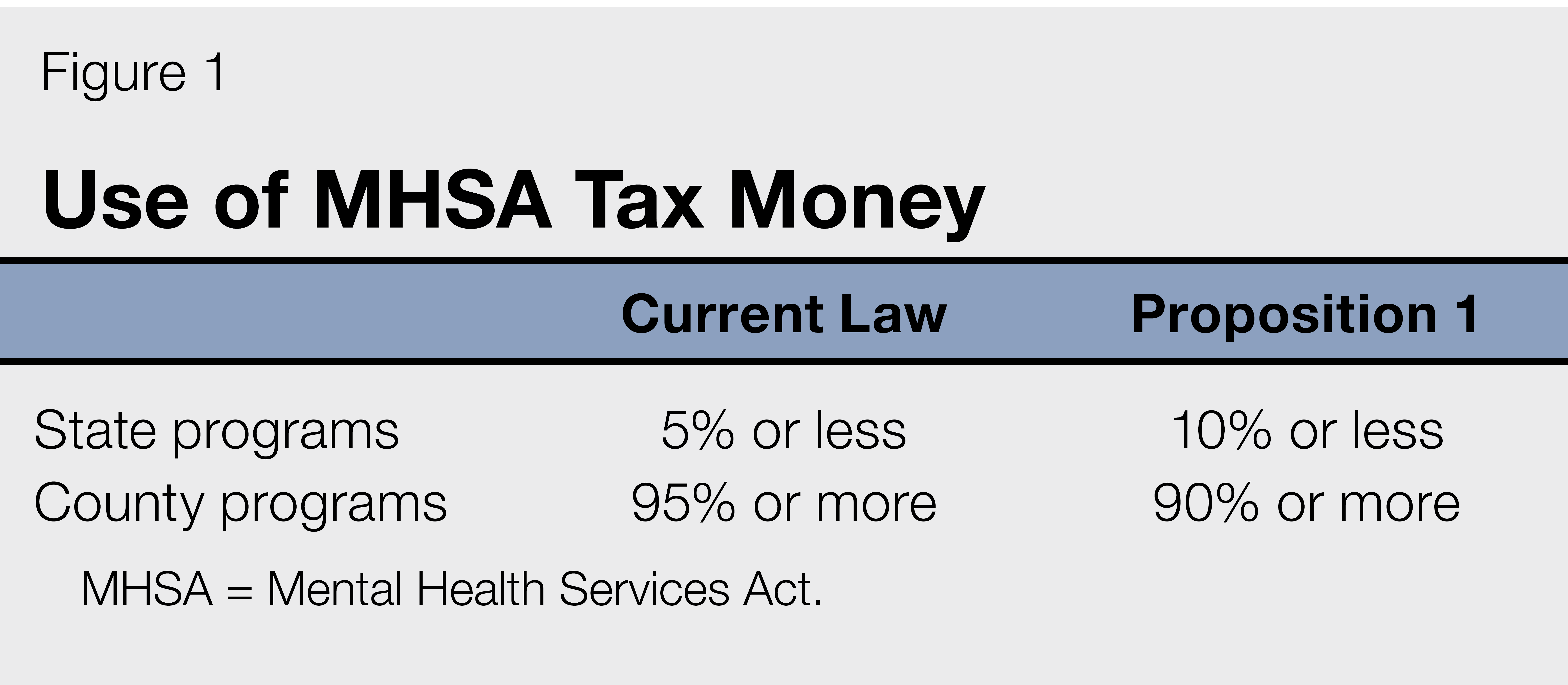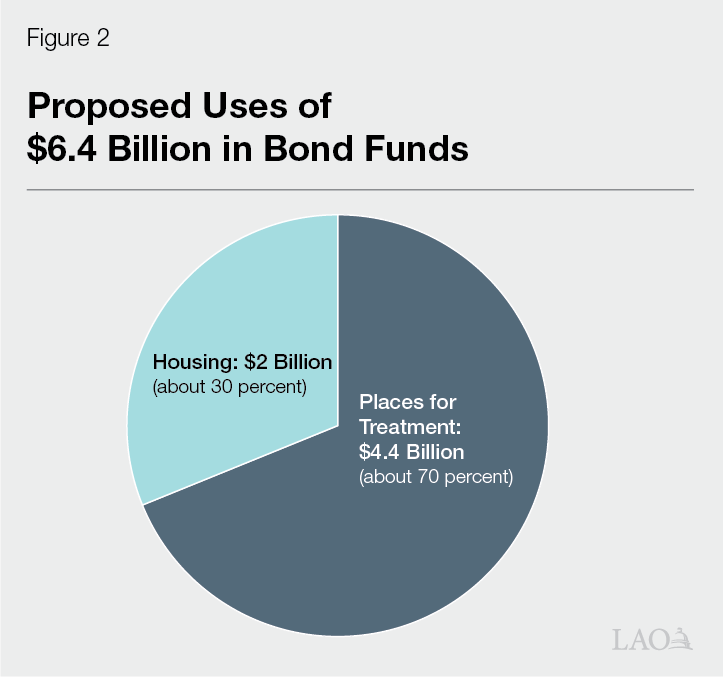Ballot Pages
Propositions on the March 5, 2024 Ballot
March 5, 2024Proposition 1
Authorizes $6.38 Billion in Bonds to Build Mental Health Treatment Facilities for Those With Mental Health and Substance Use Challenges; Provides Housing for the Homeless. Legislative Statute.
ANALYSIS OF MEASURE
OVERVIEW
Proposition 1 has two major components related to providing mental health care and drug or alcohol treatment to people and addressing homelessness. The proposition:
- Changes the Mental Health Services Act that was passed by voters in 2004, with a focus on how the money from the act can be used.
- Approves a $6.4 billion bond to build (1) more places for mental health care and drug or alcohol treatment and (2) more housing for people with mental health, drug, or alcohol challenges.
MENTAL HEALTH SERVICES ACT
Background
Counties Provide Mental Health Care and Drug or Alcohol Treatment to Certain People. Counties receive money to provide mental health care and drug or alcohol treatment. Counties generally provide these services to people with low incomes and severe mental illnesses.
A Tax on People With High Incomes Helps to Pay for County Mental Health Services. Counties receive roughly $10 billion to $13 billion per year in statewide taxes and federal money to provide mental health care and drug or alcohol treatment. Roughly one-third of the money counties receive to provide mental health services comes from a tax on people with high incomes. This tax has been collected since 2005, after California voters approved Proposition 63, also known as the Mental Health Services Act (MHSA). The act taxes people with incomes over $1 million per year and requires that the money collected from the tax be used for mental health services. The tax typically raises between $2 billion and $3.5 billion each year (annually).
Under MHSA, Counties Have Some Choices About How to Provide Services. Nearly all the money from the tax—at least 95 percent—goes directly to counties, which use it for mental health services. The rest of the money goes to the state to support mental health programs. Counties can only spend the MHSA money on certain types of services, but have flexibility in how to provide those services. The services include treatment for people with mental illness and prevention programs for people who may develop a mental illness. While counties can spend MHSA money on treatment for drugs and alcohol, the people receiving treatment must also have a mental illness.
Proposal
No Changes to Tax. Proposition 1 does not change the tax on people with incomes over $1 million per year.
State Gets Larger Share of Tax. As shown in Figure 1, Proposition 1 increases the share of the MHSA tax that the state gets for mental health programs. The proposition also requires the state to spend a dedicated amount of its MHSA money on increasing the number of mental health care workers and preventing mental illness and drug or alcohol addiction across communities. Because the state would receive a larger share of the tax, counties would receive a somewhat smaller share.

Changes to How Counties Provide Services. Proposition 1 requires that counties spend more of their MHSA money on housing and personalized support services like employment assistance and education. While counties currently can use MHSA money to pay for these types of services, they are not required under MHSA to spend a particular amount on them now. Counties would continue to provide other mental health services under the proposition, but less MHSA money would be available to them for these other mental health services. Examples of other mental health services include treatment, responding to people in a mental health crisis, and outreach to people who may need mental health care or drug or alcohol treatment. How much counties would spend on different services would depend on future decisions by the counties and the state. The proposition also allows counties to use MHSA money on treatment for drugs and alcohol for people without a mental illness.
$6.4 BILLION BOND
Background
California Does Not Have Enough Places Where People Can Get Mental Health Care and Drug or Alcohol Treatment. People receive mental health care and drug or alcohol treatment in different types of places based in part on their need. California does not have enough places where people can get this care and treatment. This shortage means that many people wait for care or do not receive care at the right type of place. To address the shortage, places for treatment in California would need to be able to see over 10,000 more people at any one time than is possible today.
State Program Provides Money to Build More Places for Mental Health Care and Drug or Alcohol Treatment. The state budget recently included about $2 billion to build more places for mental health care and drug or alcohol treatment. The program gives grants to local governments, tribes, nonprofits, and companies. About 75 percent of this grant funding has been awarded so far. Many of these places are now being built. Examples of the types of places that are being built by this program include: (1) places where people can stay for a short amount of time in order to receive treatment for drugs or alcohol; (2) places where people can stay while they transition from intensive mental health care to lower levels of care; and (3) places where people receive the most intensive treatment and care, such as psychiatric hospitals. This program will address less than half of the statewide shortage of places for mental health care and drug or alcohol treatment. Currently, no additional state funds for this purpose are planned.
Many People in California Experience Homelessness. The high cost of housing in California means many people cannot afford housing. As of January 2022, there were 171,500 people who were experiencing homelessness in California. Of this total, 10,400 were veterans.
State Program Provides Money to Turn Hotels, Motels, and Other Buildings Into Housing. The state has many programs that build housing for Californians experiencing homelessness or those with low incomes. One such state program gives grants to local governments and tribes for various purposes, including to turn hotels, motels, and other buildings into housing and construct new housing. Recent state budgets have given $3.7 billion to this program.
Proposal
New Bonds to Build More Places for Mental Health and Drug or Alcohol Treatment and More Housing. Proposition 1 allows the state to sell $6.4 billion in new bonds. Bonds are a way that the state borrows money and then repays the money plus interest over time. For more information about bonds, see “Overview of State Bond Debt” later in this guide.
Use of Funds. Figure 2 shows how the bond funding would be used.
- Places for Mental Health Care and Drug or Alcohol Treatment. Proposition 1 would give up to $4.4 billion to the state program that builds more places for mental health care and drug or alcohol treatment. The types of places that would be built with bond funds would depend on future decisions by the state. Proposition 1 would require at least $1.5 billion of the $4.4 billion to go to local governments and tribes.
- Housing. Proposition 1 would give $2 billion to the state program that gives money to local governments to turn hotels, motels, and other buildings into housing and construct new housing. Local governments would get either grants or loans from the state. The housing added by the measure would be for people who are (1) experiencing homelessness or at risk of becoming homeless and (2) have mental health, drug, or alcohol challenges. Just over half of the $2 billion would be set aside for veterans.

FISCAL EFFECTS
MHSA
More MHSA Money to the State, Less to Counties. There would be no changes to the MHSA tax, but the money would be used differently. The proposition shifts roughly $140 million annually of MHSA money from the counties to the state. This amount would be higher or lower depending on the total amount of MHSA money collected annually.
Possible Increased Costs to Counties to Continue Current Programs. Counties would provide more housing and personalized support services, but would have less MHSA money for other mental health services. This means counties may need to use other county, state, or federal money to keep current service levels.
Bond
Increased State Costs of $310 Million Annually for 30 Years to Repay the Bond. We estimate the cost to repay the bond would be about $310 million annually over a 30-year period. Payments would be made from the state General Fund. (The General Fund is the account the state uses to pay for most public services, including education, health care, and prisons.) This would be less than one-half of 1 percent of state General Fund revenue. Since the state has to pay interest on the money it borrows, the total cost of the bond would be about 10 percent more expensive than if the state paid in cash.
Funding for Local Governments. Local governments and tribes would receive grants and loans funded by the bond to build more places for mental health care and drug or alcohol treatment and more housing for people with mental health, drug, or alcohol challenges. These governments would have to pay for some of the costs to operate these places and housing.
How Would the Bond Impact the Shortage of Places for Mental Health and Drug or Alcohol Treatment? The state government estimates that the bond would build places for 6,800 people to receive mental health care and drug or alcohol treatment at any one time. While the measure would build a lot of new treatment places, there may still be some need for new places after the bond funds are spent.
How Would the Bond Impact Homelessness? The state government estimates the bond would build up to 4,350 housing units, with 2,350 set aside for veterans. The bond would provide housing to over 20 percent of veterans experiencing homelessness. The number of housing units built by the bond would reduce statewide homelessness by only a small amount.
YES/NO STATEMENT
A YES vote on this measure means: Counties would need to change some of the mental health care and drug or alcohol treatment services provided currently to focus more on housing and personalized support services. The state could borrow up to $6.4 billion to build (1) more places where people could get mental health care and drug or alcohol treatment and (2) more housing for people with mental health, drug, or alcohol challenges.
A NO vote on this measure means: Counties would not need to change the mental health care and drug or alcohol treatment services provided currently. The state could not borrow up to $6.4 billion to build more places where people could get mental health care and drug or alcohol treatment and more housing for people with mental health, drug, or alcohol challenges.
SUMMARY OF LEGISLATIVE ANALYST'S ESTIMATE OF NET STATE AND LOCAL GOVERNMENT FISCAL IMPACT
- Shift roughly $140 million annually of existing tax revenue for mental health, drug, and alcohol treatment from counties to the state.
- Increased state costs to repay bonds of about $310 million annually for 30 years. These bond funds would be used to build (1) more places where people can get mental health care and drug or alcohol treatment and (2) more housing for people with mental health, drug, or alcohol challenges.

BALLOT LABEL
Fiscal Impact: Shift roughly $140 million annually of existing tax revenue for mental health, drug, and alcohol treatment from counties to the state. Increased state bond repayment costs of $310 million annually for 30 years.